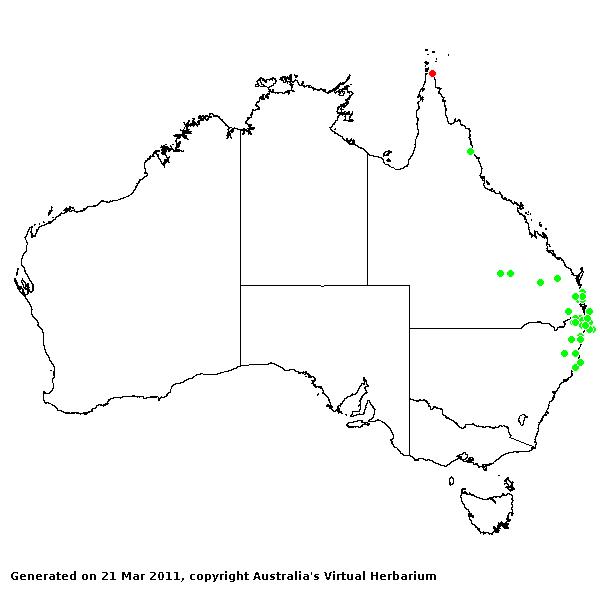Arthraxon P.Beauv.,. Essai Agrost.
111 (1812).
Derivation:.
From Greek arthron (joint) and axon (axis), alluding to the
jointed rachis.
Taxonomic
revisions, nomenclatural references:. P.C.van Welzen, Blumea 27:
255–300 (1981).
Key references
(keys and floras):. G.Bentham, Flora Australiensis 7: 523–524
(1878); J.W.Vickery, Flora of New South Wales, Gramineae 19: 28–29
(1961); E.E.Henty, Manual Grasses New Guinea 32 (1969);
M.Lazarides, Tropical Grasses S.E. Asia 21–22 (1980); J.C.Tothill and
J.B.Hacker, Grasses of Southern Queensland 112–113 (1983); B.K.Simon, Key
to Australian Grasses 73 (1993); D.Sharp and B.K.Simon, AusGrass (2002);
S.W.L.Jacobs, R.D.B.Whalley & D.J.B.Wheeler, Grasses of New South Wales,
4th Ed, 134 (2008).
W.D.Clayton &
S.A.Renvoize, Genera Graminum (1986), genus (610).
Native. 7 species,
from tropical Africa, Madagascar, Mauritius, Indomalayan region (with most
species in India) to Japan and Australia. 2 species in Australia, Qld and NSW.
Also New Guinea and Malesia.
Habit. Annual
or perennial (often trailing), decumbent. Leaf blades broad or narrow, cordate.
Ligule a fringed membrane (short).
Inflorescence.
Inflorescence of spicate main branches, of digitate or subdigitate racemes or spikes,
usually subdigitate or non-digitate (when the racemes solitary), not a compound
pseudo-inflorescence (but the inflorescences terminal and/or axillary).
Spikelet-bearing axes spikes (rarely) or racemes (usually), with heteromorphic
spikelets or with homomorphic spikelets, clustered, with spikelets in pairs,
one sessile, the other pedicelled, disarticulating at joints. Internodes
disarticulating transversely.
Spikelets.
Spikelets laterally compressed or dorsally compressed, 2 flowered, with 1
fertile floret, solitary (rarely) or paired, sessile (the pedicelled spikelets
sometimes completely suppressed) or sessile and pedicelled (but the latter
often much reduced), when paired in pedicelled/sessile combinations; sessile
spikelet with lower incomplete floret. Fertile spikelets falling with glumes.
Glumes. Glumes
more or less equal, long relative to adjacent lemmas, awnless, dissimilar (the
lower often leathery, rounded on the back, the upper less firm, laterally
compressed). Lower glume more or less two-keeled or not two-keeled, convex on
back, rugose to prickly (sometimes with lateral rows of tubercles or spines),
5–20 nerved. Upper glume 1–5 nerved.
Florets. Lower
incomplete floret(s) sterile. Lemmas awnless, 0–1 nerved, more or less
equalling fertile lemmas, similar in texture to fertile lemmas (membranous),
not becoming indurated. Fertile florets 1. Lemmas ovate-lanceolate, less firm
than glumes (hyaline), not becoming indurated, entire at apex or incised,
pointed to blunt (acute to erose), awned (nearly always), without a germination
flap, 1 nerved or 3 nerved, glabrous, not keeled. Awns 1, dorsal, geniculate,
hairless (glabrous), much shorter than body of lemma to much longer than body
of lemma. Palea present or absent, when present very reduced, entire
(triangular, subacute), membranous, nerveless, not keeled. Lodicules 2. Stamens
1–3. Grain fusiform or ellipsoid, slightly compressed laterally. Hilum short.
Embryo large. Pedicels (when present) free of rachis. Pedicelled spikelets
present or absent or much reduced.
Kranz Anatomy.
C4.
2n = 18,
20, 36, and 40, 2 and 4 ploid.
Habitat.
Helophytic to mesophytic. Shade species, or species of open habitats.
Classification.
Panicoideae; Andropogoneae.
Notes. A
homogeneous genus with a basic chromosome number of 9, and several unusual
features which make it difficult to classify. The most plausible comparison is
with Schizachyrium, in which the awn is also sometime basal though from
a bifid lemma, a comparison supported by the 2-keeled lower glumes of some
Arthraxon species (Clayton and Renvoize, 1986).
Types Species. A.
ciliaris P.Beauv. = A. hispidus (Thunb.) Makino.
Biogeographic
Element. Clifford & Simon 1981, Simon & Jacobs 1990: Old World
Tropics.


